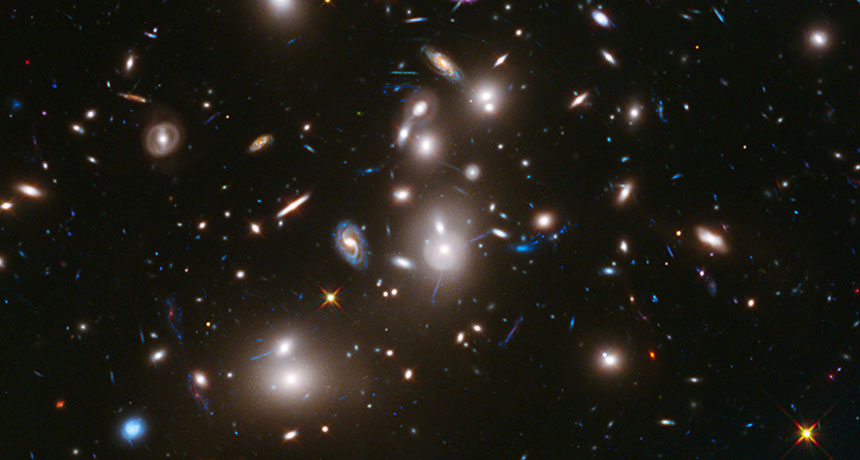Cosmic threads may hide some of universe’s missing matter
Astronomers seek lost atoms in hard-to-see filaments between galaxy clusters

SCAVENGER HUNT The massive galaxy cluster Abell 2744, seen in this Hubble Space Telescope image, sits at the nexus of three galactic filaments that might house some of the universe's missing matter.
NASA, ESA
- More than 2 years ago
HONOLULU — Some people have trouble finding their keys; astronomers, meanwhile, have been having trouble locating half of the atoms in the universe. Fortunately, researchers have a good idea of where to look. The misplaced matter seems to have collected in cosmic filaments, hundreds of millions of light-years long, which connect galaxy clusters across the cosmos.
Three such filaments extending from the galaxy cluster Abell 2744 (SN: 6/13/15, p. 32) are loaded with gas that’s hoarding some of the missing mass, says Dominique Eckert, an astrophysicist at the University of Geneva in Switzerland. The temperature and density of the gas closely match those from computer simulations implicating gas filaments as a hiding place, Eckert reported August 3 at meeting of the International Astronomical Union.
“We have a pretty good idea of how much ordinary matter there is in the universe,” says Eckert. “Except if we make a census of everything we see in the local universe, we fall short.” In its formative years, the matter in the universe was made up of about 15 percent “normal matter” — the atoms that make up stars, planets and people — and 85 percent dark matter, the far more elusive stuff that reveals itself only by its gravity. When researchers take a look around at the modern universe, however, half of that normal matter is missing (SN: 8/9/14, p. 22).
In their search for the missing matter, astronomers tend to follow the light. Unfortunately, the relatively cool gas flowing along filaments hides in the shadows. This gas, cooked to a balmy 100,000 to 10 million degrees Celsius, glows with hard-to-see ultraviolet light; the much hotter gas that collects in galaxy clusters blasts out highly detectable X-rays. Hydrogen clouds that roam between galaxies are good at intercepting and blocking UV light, whereas X-rays zap right through. So when it comes to UV light, “we are essentially blind,” says Eckert.
Some of the filament gas is just warm enough to leak out a faint trickle of X-rays, though. By pointing the XMM-Newton telescope toward Abell 2744, which lurks about 4 billion light-years away in the constellation Sculptor, Eckert and colleagues detected the ghostly X-ray glow of these previously hidden filaments.
“They’re very faint,” says Christine Jones, an astrophysicist at the Harvard-Smithsonian Center for Astrophysics in Cambridge, Mass. “The measurement is very hard to do.” Astronomers have previously had only one reasonable example of a filament connecting two galaxy clusters, she says. But with the filaments sticking out of Abell 2744, and another that Jones has detected joined up to a different cluster, “there are now becoming more examples.”
Just seeing the filaments isn’t enough. Eckert weighed the filaments by looking at how their mass bends the light coming from galaxies sitting far beyond the cluster. Contortions in the images of these galaxies, which align nicely with the X-ray glow, provide clues to the total mass (including dark matter) trapped in the filaments. The X-ray light then tells the researchers what fraction of that mass is in the ordinary matter found in the warm gas: about 5 to 10 percent.
Throw in a bit more mass hiding as cooler gas, and a few percent bound up in stars, and the gas mass in filaments approaches what researchers would expect if that’s where the misplaced matter is hiding. The numbers found by Eckert seem reasonable, Jones says, based on the balance of dark and normal matter found in galaxies, galaxy groups and clusters.







